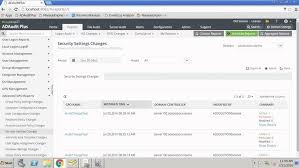The Importance of Active Directory Auditing
Active Directory (AD) is a crucial component of most organisations’ IT infrastructure, serving as a centralised database that stores and manages user accounts, computer information, and security policies. With the increasing number of cyber threats and regulatory requirements, ensuring the security and compliance of your AD environment is more important than ever.
AD auditing plays a vital role in maintaining the integrity and security of your network. By conducting regular audits, organisations can track user activities, monitor changes to configurations, detect potential security breaches, and ensure compliance with industry regulations such as GDPR, HIPAA, or PCI DSS.
Benefits of AD Auditing:
- Enhanced Security: By monitoring user activities and tracking changes in AD settings, organisations can quickly identify suspicious behaviour or unauthorised access attempts.
- Compliance: Auditing helps organisations demonstrate compliance with regulatory requirements by providing detailed reports on access controls, data modifications, and user permissions.
- Improved Troubleshooting: Auditing logs can help IT teams troubleshoot issues more efficiently by providing insights into system errors or policy violations.
- Audit Trail: Having a comprehensive audit trail allows organisations to investigate security incidents, track down the source of data breaches, and prevent future attacks.
In conclusion, active directory auditing is a critical practice for any organisation looking to secure their IT environment, protect sensitive data, and meet compliance standards. By implementing robust auditing processes and leveraging advanced audit tools, businesses can proactively safeguard their AD infrastructure against threats and ensure the smooth operation of their network.
Understanding and Conducting an Ad Audit: Key Questions and Methodologies
- How do I run an ad audit?
- What is an ad audit?
- What is the audit methodology of Active Directory?
- How do you audit ad changes?
How do I run an ad audit?
Running an Active Directory (AD) audit involves a series of steps to ensure the security and compliance of your IT environment. To initiate an AD audit, start by defining the scope of the audit, including the specific areas you want to assess such as user accounts, group policies, or access controls. Next, select a reliable AD auditing tool that aligns with your requirements and can provide detailed insights into AD activities. Configure the auditing tool to monitor and track changes within your AD environment, including user logins, account modifications, and permission changes. Once the audit is set up, regularly review and analyse the generated reports to identify any anomalies or potential security risks. By following these steps and maintaining a proactive approach to AD auditing, you can enhance the security posture of your organisation and ensure regulatory compliance.
What is an ad audit?
An AD audit, short for Active Directory audit, is a systematic examination and evaluation of an organisation’s Active Directory environment to ensure its security, compliance, and operational efficiency. During an AD audit, IT professionals review user activities, permissions settings, configuration changes, and access controls within the Active Directory system. By conducting regular AD audits, organisations can identify potential security vulnerabilities, detect unauthorised access attempts, track changes made to critical settings, and maintain compliance with industry regulations. Overall, an AD audit is a proactive measure that helps businesses strengthen their IT security posture and mitigate risks associated with managing user accounts and network resources within the Active Directory infrastructure.
What is the audit methodology of Active Directory?
The audit methodology of Active Directory involves a systematic process of evaluating and monitoring the security, configuration, and activity within an organisation’s Active Directory environment. This methodology typically includes identifying critical assets and resources within the AD, establishing audit policies and procedures, conducting regular audits to assess compliance with security standards and regulations, analysing audit logs for anomalies or suspicious activities, and implementing corrective measures to address any identified issues. By following a structured audit methodology, organisations can enhance their overall security posture, mitigate risks, and ensure the integrity of their Active Directory infrastructure.
How do you audit ad changes?
Auditing Active Directory (AD) changes involves monitoring and tracking modifications made to user accounts, group policies, permissions, and other configurations within the AD environment. Organisations can implement various methods to audit AD changes effectively, such as enabling auditing policies in AD to log events, using third-party auditing tools for more comprehensive monitoring, and regularly reviewing audit logs to detect any suspicious activities or unauthorised modifications. By establishing robust auditing processes and leveraging advanced technologies, organisations can proactively identify and respond to changes in their AD environment, enhancing security, compliance, and overall IT governance.

